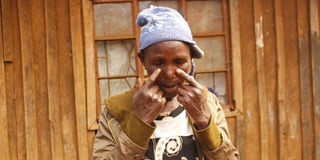Surgeries in anti-trachoma campaign help locals regain eyesight

Margaret Mwari from Kithetu Igembe North recounts her experience after undergoing eye surgery to correct trachoma infection.
For more than 20 years, Ms Margaret Mwari, from Kithetu village in Igembe North, suffered from partial blindness caused by a trachoma infection.
Trachoma is caused by a bacteria known as chlamydia trachomatis that attacks the inner surface of the eyelids.
This causes the eyelashes to rub on the cornea, leading to scars that may eventually lead to blindness.
Ms Mwari had shunned treatment until February 2021, when a community health volunteer visited and convinced her to go for a free medical checkup and surgery.

Esther Nkoyai from Mutuati in Igembe North. She is one of the beneficiaries of free surgery under the trachoma eradication programme.
Before the surgery, her eyes kept oozing a discharge that rendered her blind during the night and restless during the day.
“I kept wiping my eyes and plucking out the eyelids, and the skin below the eyes had turned black due to years of wiping. The eyes were always teary and red. I had a lot of discomfort and when night fell, I had to be helped around,” Mwari recounted.
Today, Ms Mwari’s eyes have stopped clogging and the night blindness she struggled with is gone.
“I am very grateful to those who treated me. I am now an eye hygiene ambassador in my village. I encourage more people to seek medical attention immediately,” she said.
She then urged area community health volunteer Henry Mung’athia to add two locals suspected to have trachoma to his list of interventions.
Ms Mwari is among more than 130 residents of Igembe North, where trachoma is endemic, who have undergone surgeries this year in a campaign to eliminate the disease.
An initiative to eliminate trachoma saw more than 3,400 people undergo surgeries between 2014 and 2019, said Aphiud Njeru, the AIC Health Ministries prevention of blindness programme manager.
The initiative under the Kenya trachoma elimination programme arose from a 2008 survey that found that Meru had one percent prevalence.
“AIC Health Ministries was contracted by CBM to implement the programme in Meru North in 2014. We focused on surgeries, provision of antibiotics, face washing and toilet hygiene. Our target was to reach more than 2,400 people affected by trachoma but by 2019, we had surpassed the number,” Mr Njeru said.
A follow-up impact study indicated that trachoma had been suppressed in Tigania West, Tigania East, Igembe South and Igembe Central, but not Igembe North.
Trachoma, he said, remains a public health concern in Igembe North due to low toilet coverage that leads to open defecation.
“Over the last two years, we have concentrated on enhancing hygiene as well as house to house identification of trachoma patients. This has led to a reduction of prevalence to 0.84 per cent,” he said.

Igembe North Community health services coordinator Rachel Mueni shows a toilet stool meant for disability friendly pot latrines. Access to toilets is key to elimination of trachoma which has been endemic to the area.
An area is declared trachoma-free when prevalence among adults is below 0.2 percent and under five per cent among children, says the World Health Organisation (WHO).
Active trachoma in Igembe North has been reduced through a robust community health strategy, said Rachel Mueni, the Igembe North community health services coordinator.
“We have 300 community health volunteers who monitor every home for toilet coverage and any cases of trachoma. Poor disposal of faecal matter is a major cause of trachoma,” Ms Mueni said.
“We are working with communities to ensure every family has a proper pit latrine. We are also supporting families and schools to have disability-friendly latrines.”
To ensure all cases of trachoma are identified, volunteers have been trained on identifying symptoms and referring patients to hospitals.
“Identification of trachoma patients is as critical as hygiene in its elimination. We have also set up community health desks at dispensaries where suspected cases are referred to specialists. Once a case is identified, we organise free surgeries,” she said.
Ms Mueni said the county government, with support from the partners, has set up eye clinics at Mutuati, Nyambene and Miathene Level Four hospitals to ease access to eye screening and surgeries.
Last year, after the area registered a worrying rate of infections, more than 158,000 residents of Igembe North received antibiotics in a mass drug administration drive aimed at treating trachoma and preventing spread.





